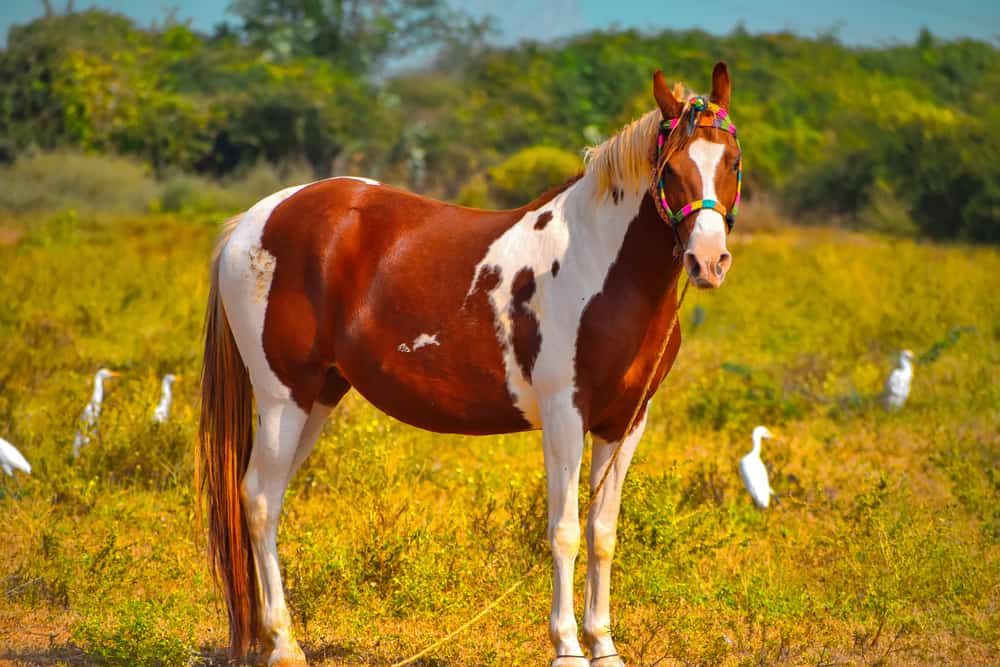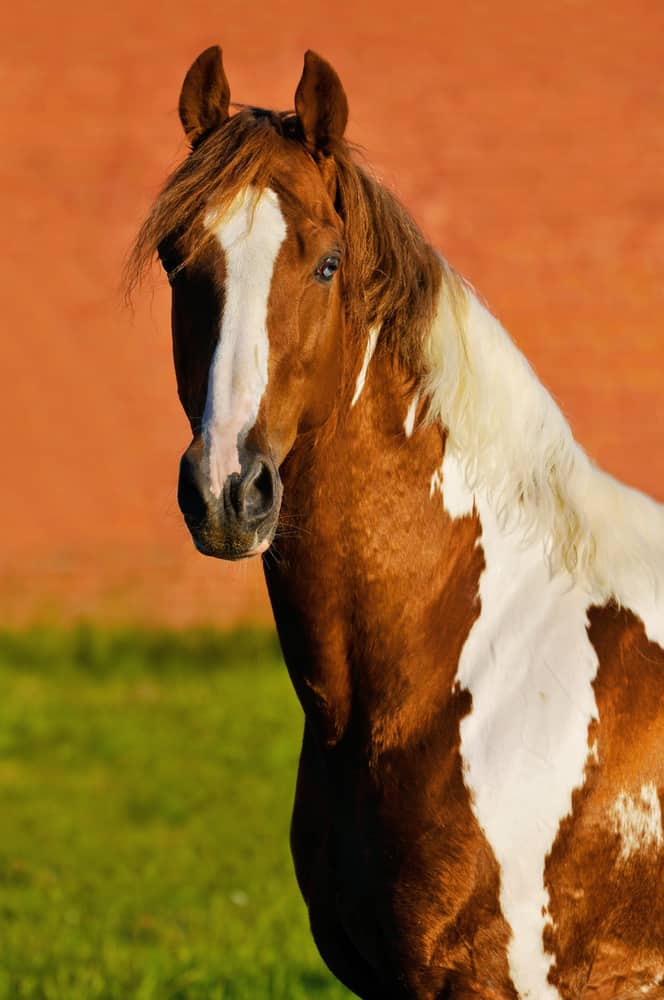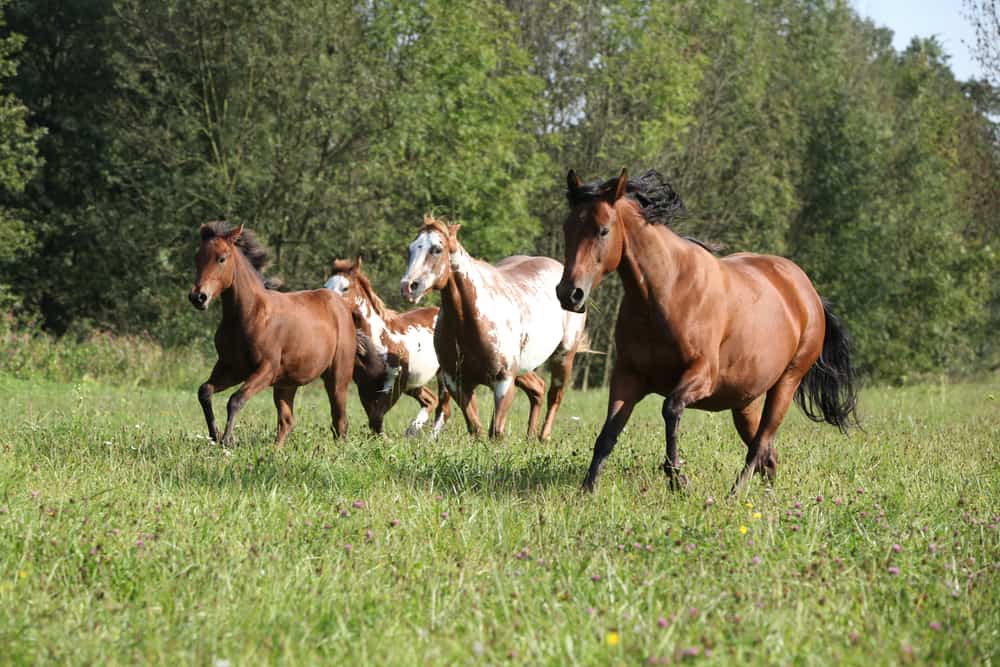Black, bay, brown, chestnut, palomino, buckskin, and gray are some of the hues found in American Quarter Horses. Each color has its own unique set of markings that can be used to identify an individual horse.
But did you know that American Quarter Horses also have various marking patterns? These markings, often found on the face and legs of the horse, add even more individualism to these already unique animals.

Common marking patterns include star, stripe, snip, blaze, bald face, and coronet. A horse can have one or a combination of these markings, making each animal unique.
Take, for example, a black American Quarter Horse with a star and snip on its face and four white socks – this specific combination is not likely to be duplicated.
Table of Contents
How to Identify an American Quarter Horse by Color
First, let’s start with what an American Quarter Horse is. This breed is known for its athleticism and agility in sprinting short distances. They are commonly used for cow-working, barrel racing, and even pleasure riding.

Several variations can be found within the breed when identifying an American Quarter Horse by color. A black American Quarter Horse will have a solid black coat without visible markings or other pigments.
Bay American Quarter Horses are brown overall, with black markings on the legs, mane, and tail. Brown American Quarter Horses have solid chocolate-brown coats all over their body. Chestnut American Quarter Horses have a reddish or golden-brown jacket with no black points present.
Palomino American Quarter Horses have a cream-colored body, flaxen mane, and tail. Buckskin American Quarter Horses have a gold or tan base coat with black points on their legs, fur, and tail. Lastly, gray American Quarter Horses may appear white or silver, but they usually have black skin underneath their hair coat.
Remember that various shades and markings can also be present within each of these colors. For example, a bay American Quarter Horse may range from a light amber color to a dark mahogany shade. And all colors may also possess white markings, such as socks or blazes on their face.
The Different Colors of American Quarter Horses
Some standard colors seen in American Quarter Horses are black, bay, brown, chestnut, palomino, buckskin, and gray. While all these colors are beautiful, some may be more desirable than others, depending on your preferences. Let’s look at each color closely and see what sets them apart!

Black American Quarter Horses are considered to be the rarest of all colors, and they are also the most sought-after. They have a sleek and regal appearance that is truly unique, and they are often favored by those who want to make a statement.
The bay American Quarter Horse is famous because of its beauty and adaptability. They are available in a wide range of tones, from pale to deep, and can be used for almost any purpose. Brown American Quarter Horses are another popular choice, as they are known for being solid and reliable.
They come in a wide range of shades, from light chocolate to deep mahogany, and they are perfect for those who need a horse that can do it all. Chestnut American Quarter Horses are another beloved breed, as they are known for being both sweet and courageous. Trail horses range from delicate cream to deep nutmeg.
Palomino American Quarter Horses are also quite popular due to their mild temperament and attractive appearance. They come in shades from light gold to dark amber and are perfect for those who want a beautiful horse that is easy to handle. Buckskin American Quarter Horses are another favored breed, as they are known for being sturdy and hardworking.
The Most Common Colors of American Quarter Horses
When you think of American Quarter Horses, the colors that come to mind are usually black, bay, brown, and chestnut. These are the four most common colors of American Quarter Horses, accounting for most horses in this breed.

Each of these colors has its unique characteristics and personality. For example, black American Quarter Horses are often seen as solid and robust, while bay horses are known for their intelligence and good temperament.
Chestnut horses are also known for their excellent temperament and tend to be very athletic and fast. Brown horses are sometimes described as “the all-around horse” because they can do pretty much anything.”
But American Quarter Horses come in a variety of other colors as well, like palomino, buckskin, and gray. These may not be as common as the four mentioned above, but they still make up a significant portion of the breed.
Palominos are known for their beautiful golden coat and white mane and tail. Buckskins have a unique color combination of yellow-gold and brown, often with black points (mane, tail, legs). And gray horses start a solid color before gradually turning white over time.
No matter what color they are, American Quarter Horses are known for their versatility and agility in events such as barrel racing and roping. So whether you prefer the classic black, bay, brown, or chestnut, or the unique palomino, buckskin, or gray, American Quarter Horses are an excellent choice for any equestrian.
What Gives American Quarter Horses Their Unique Colors?
One of the most apparent factors contributing to a horse’s color is its genetics. This means that the genes determine the color of a horse it inherits from its parents. Some colors are more common than others, and specific genes are more likely to produce a particular color.

Another factor that can contribute to a horse’s color is its diet. Carotenoids in the diet may increase the likelihood of a horse being a chestnut or palomino. Similarly, if a horse eats a diet high in melanin, it may be more likely to be black. This is because carotenoids and melanin are two of the substances that can cause a horse’s coat to change color.
Finally, the environment can also play a role in a horse’s coloring. For instance, if a horse lives in an area with many trees, it may be darker in color than if it lives in a room with less vegetation. This is because horses tend to absorb certain environmental chemicals, which can affect their coloring.
A Look at the Various Markings of American Quarter Horses
The American Quarter Horse is a breed of horse that is known for its distinctive coloring and markings. These horses come in various colors: black, bay, brown, chestnut, palomino, buckskin, and gray.

While their coloring is beautiful and unique, so are their markings. Some standard markings include stockings on their legs, a blaze on their face, and a coronet on their head. Let’s take a closer look at some of these markings and what they mean!
One standard marking is the stocking on a horse’s leg. This marking is simply a stripe of color that goes around the leg. It can be any color but typically appears black or white. The characteristic stocking marking is commonly connected with quickness and agility.
Another standard marking is the blaze on a horse’s face. This marking is a wide stripe of color that goes down the middle of the beginning from the forehead to the muzzle. Although often seen in black or white, it comes in any color. Many cultures view fire as a symbol of bravery and resolve.
The coronet is another standard marking on American Quarter Horses. This marking is a small circle of color that sits at the top of the horse’s head, just in front of the ears. It can be any color but is typically black or white. The coronet is often associated with intelligence and wisdom.


